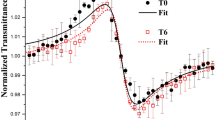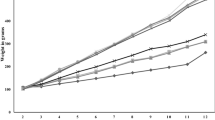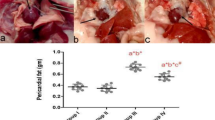Abstract
Background/Objectives:
In vitro and animal studies have reported that young broccoli sprouts improve oxidative stress status in diabetic condition. The objective of this double-blind, placebo-controlled, randomized clinical trial was to investigate the effects of broccoli sprouts powder (BSP) on some oxidative stress parameters in type 2 diabetes patients.
Subjects/Methods:
A total of 81 patients with type 2 diabetes were randomly assigned to one of three treatment groups for 4 weeks. The groups received either 10 g/d BSP (n=27), 5 g/d BSP (n=29) or placebo (n=25). Serum total antioxidant capacity (TAC), total oxidant status (TOS), oxidative stress index (OSI), malondialdehyde (MDA) and oxidized low density lipoprotein (LDL) cholesterol were measured at baseline and at 4 weeks after treatment.
Results:
In all, 63 patients in three groups were included in the analysis: 10 g/d BSP (n=21), 5 g/d (n=22) and placebo (n=20). After 4 weeks, consumption of BSP resulted in significant decrease in MDA (P=0.001 for treatment effect), oxidized low density lipoprotein cholesterol (P=0.03 for treatment effect), OSI (P=0.001 for treatment effect) and significant increase in TAC (P=0.001 for treatment effect). No effects were found on TOS.
Conclusion:
BSP had favorable effects on oxidative stress status in type 2 diabetes patients.
This is a preview of subscription content, access via your institution
Access options
Subscribe to this journal
Receive 12 print issues and online access
$259.00 per year
only $21.58 per issue
Buy this article
- Purchase on Springer Link
- Instant access to full article PDF
Prices may be subject to local taxes which are calculated during checkout


Similar content being viewed by others
References
Altomare E, Vendemiale G, Chicco D, Procacci V, Cirelli F (1992). Increased lipid peroxidation in type 2 poorly controlled diabetic patients. Diabete Metab 18, 264–271.
Angeloni C, Leoncini E, Malaguti M, Angelini S, Hrelia P, Hrelia S (2009). Modulation of Phase II enzymes by sulforaphane: Implications for its cardioprotective potential. J Agric Food Chem 57, 5615–5622.
Aslan M, Sabuncu T, Kocyigit A, Celik H, Selek S (2007). Relationship between total oxidant status and severity of diabetic nephropathy in type 2 diabetic patients. Nutr Metab Cardiovasc Dis 17, 734–740.
Bekyarova GY, Ivanova DG, Madjova VH (2007). Molecular mechanisms associating oxidative stress with endothelial dysfunction in the development of various vascular complications in diabetes mellitus. Folia Med 49, 13–19.
Cao Z, Tsang M, Zhao H, Li Y (2003). Induction of endogenous antioxidants and phase 2 enzymes by alpha-lipoic acid in rat cardiac H9C2 cells: protection against oxidative injury. Biochem Biophys Res Commun 310, 979–985.
Carvajal M, Berenguer C, Viguera C (2006). Chemical and biological characterisation of nutraceutical compounds of broccoli. J Pharma Biochem Anal 41, 1508–1522.
Chisolm GM, Steinberg D (2000). The oxidative modification hypothesis of atherogenesis: an overview. Free Radic Biol Med 28, 1815–1826.
Cho EJ, Lee YA, Yoo HH, Yokozawa T (2006). Protective effects of broccoli (Brassica oleracea) against oxidative damage in vitro and in vivo. J Nutr Sci Vitaminol 52, 437–444.
Cumurcu BE, Ozyurt H, Etikan I, Demir S, Karlidag R (2009). Total antioxidant capacity and total oxidant status in patients with major depression: impact of antidepressant treatment. Psychiatry Clin Neurosci 63, 639–645.
Dembinska-Kiec A, Mykkänen O, Kiec-Wilk B, Mykkänen H (2008). Antioxidant phytochemicals against type 2 diabetes. Br J Nutr 99, ES109–ES117.
Dinkova-Kostova AT, Fahey JW, Wade KL, Jenkins SN, Shapiro TA, Fuchs EJ (2007). Induction of the Phase 2 response in mouse and human skin by sulforaphane-containing broccoli sprouts extracts. Cancer Epidemiol Biomarkers Prev 16, 847–851.
Erel O (2004a). A novel automated direct measurement method for total antioxidant capacity using a new generation, more stable ABTS radical cation. Clin Biochem 37, 277–285.
Erel O (2004b). A novel automated method to measure total antioxidant response against potent free radical reactions. Clin Biochem 37, 112–119.
Evans JL, Goldfine ID, Maddux BA, Grodsky GM (2002). Oxidative stress and stress-activated signaling pathways: a unifying hypothesis of type 2 diabetes. Endocr Rev 23, 599–622.
Fahey J, Talalay P (1999). Antioxidant function of sulforaphane: a potent inducer of phase 2 detoxyfication enzymes. Food Chem Toxicol 37, 973–979.
Goycheva V, Gadjeva B, Popov (2004). Oxidative stress and its complications in diabetes mellitus. Trakia J Sci 4, 1–8.
Jeffery E, Araya M (2009). Physiological effects of broccoli consumption. Phytochem Rev 8, 283–298.
Jurlink B (2001). Therapeutic potential of dietary phase 2 enzyme inducer in ameliorating diseases that have an underlying inflammatory component. Can J Physiol Pharmacol 79, 266–282.
Keum Y, Jeong W, Kong T (2004). Chemoprevention by isothiocyanates and underlying molecular signaling mechanisms. Mut Res 555, 191–202.
Likidlilid A, Patchanans N, Peerapatdit T, Sriratanasathavorn C (2010). Lipid peroxidation and antioxidant enzyme activities in erythrocytes of type 2 diabetic patients. J Med Assoc Thai 93, 682–693.
Memişoğullari R, Bakan E (2004). Levels of ceruloplasmin, transferrin, and lipid peroxidation in the serum of patients with type 2 diabetes mellitus. J Diabetes Complications 18, 193–197.
Menke T, Niklowitz P, de Sousa G, Reinehr T, Andler W (2004). Comparison of coenzyme Q10 plasma levels in obese and normal weight children. Clin Chim Acta 349, 121–127.
Murashima M, Watanabe S, Zhuo XG, Uehara M, Kurashige A (2004). Phase 1 study of multiple biomarkers for metabolism and oxidative stress after one-week intake of broccoli sprouts. Biofactors 22, 271–275.
Nakhjavani M, Esteghamati A, Nowroozi S, Asgarani F, Rashidi A, Khalilzadeh O (2010). Type 2 diabetes mellitus duration: an independent predictor of serum malondialdehyde levels. Singapore Med J 51, 582–585.
Opara EC, Abdel-Rahman E, Soliman S (1999). Depletion of total antioxidant capacity in type 2 diabetes. Metabolism 48, 1414–1417.
Pérez-Matute P, Zulet MA, Martínez JA (2009). Reactive species and diabetes: counteracting oxidative stress to improve health. Curr Opin Pharmacol 9, 771–779.
Piao XL, Kim HY, Yokozawa T, Lee YA, Piao XS, Cho EJ (2005). Protective effects of broccoli (Brassica oleracea) and its active components against radical-induced oxidative damage. J Nutr Sci Vitaminol 51, 142–147.
Ping Z, Liu W, Kang Z et al (2010). Sulforaphane protects brains against hypoxic-ischemic injury through induction of Nrf2-dependent phase 2 enzyme. Brain Res 1343, 178–185.
Rabus M, Demirbağ R, Sezen Y (2008). Plasma and tissue oxidative stress index in patients with rheumatic and degenerative heart valve disease. Turk Kardiyol Dern Ars 36, 536–540.
Riedl MA, Saxon A, Diaz-Sanchez D (2009). Oral sulforaphane increases Phase II antioxidant enzymes in the human upper airway. Clin Immunol 130, 244–251.
Schulz KF, Altman DG, Moher D (2010). CONSORT 2010 Statement: updated guidelines for reporting parallel group randomized trials. J Clin Epidemiol 63, 834–840.
Son SM (2007). Role of vascular reactive oxygen species in development of vascular abnormalities in diabetes. Diabetes Res Clin Pract 77, S65–S70.
Stranges S, Dorn J, Donahue R (2008). Oxidation, type 2 diabetes, and coronary heart disease: A complex interaction. Diabetes Care 31, 1864–1866.
Thimmulappa RK, Mai KH, Srisuma S, Kensler TW, Yamamoto M, Biswal S (2002). Identification of Nrf2-regulated genes induced by the chemopreventive agent sulforaphane by oligonucleotide microarray. Cancer Res 62, 5196–5203.
Valko M, Leibfritz D, Moncol J, Cronin MT, Mazur M, Telser J (2007). Free radicals and antioxidants in normal physiological functions and human disease. Int J Biochem Cell Biol 39, 44–84.
Verkerk R, Schreiner M, Krumbein A (2009). Glucosinolates in brassica vegetable: the influence of the food supply chain on intake, bioavailability and human health. Mol Nutr Food Res 53 (Suppl 2), S219–S266.
Whiteside CI (2005). Cellular mechanisms and treatment of diabetes vascular complications converge on reactive oxygen species. Curr Hypertens Rep 7, 148–154.
Wu L, Juurlink BH (2001). The impaired glutathione system and its up-regulation by sulforaphane in vascular smooth muscle cells from spontaneously hypertensive rats. J Hypertens 19, 1819–1825.
Wu L, Noyan MH, Facci M (2004). Dietary approach to attenuate oxidative stress, hypertension, and inflammation in the cardiovascular system. Proc Natl Acad Sci 101, 7094–7099.
Xue M, Qian Q, Adaikalakoteswari A, Rabbani N, Babaei-Jadidi R, Thornalley PJ (2008). Activation of NF-E2-related factor-2 reverses biochemical dysfunction of endothelial cells induced by hyperglycemia linked to vascular disease. Diabetes 57, 2809–2817.
Zhu H, Jia Z, Strobl JS, Ehrich M, Misra HP, Li Y (2008). Potent induction of total cellular and mitochondrial antioxidants and phase 2 enzymes by cruciferous sulforaphane in rat aortic smooth muscle cells: cytoprotection against oxidative and electrophilic stress. Cardiovasc Toxicol 8, 115–125.
Acknowledgements
This study was funded by the Research Institute of Endocrine Sciences, Shahid Beheshti University of Medical Sciences (Tehran, Iran). The authors express appreciation to the participants of this study and would like to acknowledge the assistance given by Dr N Shakeri in data analysis and Ms N Shiva for language editing of the manuscript. None of the authors had any personal or financial conflicts of interest. The project was designed and implemented by PM and ZB. Serum sample were obtained and analyzed by ZB and MH. The data were analyzed and interpreted by ZB. The manuscript was prepared by PM, ZB, FH, SH and FA. PM and FA supervised overall project and approved the final version of the manuscript for submission.
Author information
Authors and Affiliations
Corresponding author
Ethics declarations
Competing interests
The authors declare no conflict of interest.
Rights and permissions
About this article
Cite this article
Bahadoran, Z., Mirmiran, P., Hosseinpanah, F. et al. Broccoli sprouts reduce oxidative stress in type 2 diabetes: a randomized double-blind clinical trial. Eur J Clin Nutr 65, 972–977 (2011). https://doi.org/10.1038/ejcn.2011.59
Received:
Revised:
Accepted:
Published:
Issue Date:
DOI: https://doi.org/10.1038/ejcn.2011.59
Keywords
This article is cited by
-
A mechanistic overview of sulforaphane and its derivatives application in diabetes and its complications
Inflammopharmacology (2023)
-
Sulforaphane as a Promising Natural Molecule for Cancer Prevention and Treatment
Current Medical Science (2021)
-
Dietary polyphenols as potential nutraceuticals in management of diabetes: a review
Journal of Diabetes & Metabolic Disorders (2013)
-
Trends in publication of evidence-based Traditional Iranian medicine in endocrinology and metabolic disorders
Journal of Diabetes & Metabolic Disorders (2013)



